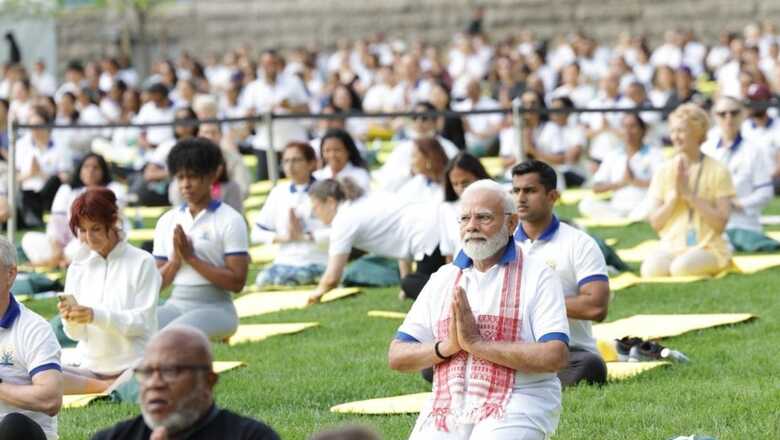
views
Yoga has experienced an undeniable surge in popularity in recent years, transcending cultural boundaries and transforming the lives of people across the globe. On June 21, 2023, we celebrated the 9th anniversary of the International Day of Yoga, with the theme being ‘Yoga For Vasudhaiva Kutumbakam,’ emphasizing the concept of “One Earth, One Family, One Future.” During his three-day visit to the United States, Prime Minister Narendra Modi led an international Yoga Day event at the United Nations headquarters in New York.
At the event, Prime Minister Modi emphasized that yoga is a way of life and a gift from India. Douglass Stewart, the co-founder of Yoga in Times Square, pointed out that yoga finds its roots in India, and it is interesting to see how Western culture has embraced it.
The great Swami Vivekananda popularised yoga in the West during his influential visit to the US in 1893. On December 11, 2014, the UN General Assembly designated June 21 as ‘International Yoga Day,’ an initiative brought forth by India. This global observance powerfully projects India’s soft power, highlighting the nation’s heritage and spreading the ancient science of yoga as a unifying force worldwide. Today, yoga has become a mainstream phenomenon embraced by billions of individuals seeking physical, mental, and emotional well-being.
Amidst the Covid-19 pandemic, yoga offered solace and support to people in the face of fear and uncertainty. The UN also recognised the significant role of yoga in the psycho-social care and rehabilitation of Covid patients in quarantine and isolation.
Yoga enhances harmony between the mind, body, and soul and fosters connection among countries, cultures, and communities. As India’s gift to the world, it bridges cultural divides and touches the lives of millions globally. While India exerts a profound influence on the global stage through multiple soft power tools, yoga stands as the pinnacle of India’s soft power.
Yoga has secured its place among the top 10 most popular fitness activities worldwide. It has also played a significant role in driving the Indian economy, as evident from its contributions to various sectors, including tourism, hospitality, and yoga centres, attracting a diverse global audience. Yoga classes generate substantial revenue and witness increased participation, especially during the summer season, further amplified by the observance of International Yoga Day, which acts as a catalyst and encourages people to start practising. Yoga studios and fitness centres alone comprise 40 percent of India’s wellness market, valued at Rs 499 billion.
In 2022, the global yoga market reached a value of approximately $105.9 billion, and it is projected to continue growing between 2023 and 2028, with a CAGR of 9 percent, as per various estimates. Major brands in the athletic wear industry, such as Adidas and Nike, have also made substantial investments in yoga apparel over the years. In May 2022, Puma launched its campaign, #YogaAnywhereEverywhere, to promote its yoga collection. The business prospects of yoga are on the rise, and its future potential is even more promising.
It has also spurred the growth of various sectors, including tourism, hospitality, and wellness centres. As yoga gains popularity worldwide, individuals seeking authentic yoga experiences flock to India, attracting significant tourists. It is very common to see foreign tourists living in places like Rishikesh and becoming practitioners of yoga. These visitors engage in yoga retreats, workshops, and teacher training programs, contributing to the local economy through their expenditures on accommodation, transportation, food, and other services. The appeal of India as a yoga destination drives job creation, stimulates entrepreneurship and enhances the tourism industry.
The economic impact of yoga extends beyond physical spaces. With the advent of digital platforms and online classes, individuals worldwide can access yoga instruction and guidance remotely. This virtual expansion of the industry opens new avenues for revenue generation and job creation. Yoga teachers and trainers can reach a global audience through online classes, workshops, and personalised sessions. This digitalisation of yoga democratises access, enhances convenience, and stimulates economic growth in the digital space. There are specific YouTube channels dedicated to yoga from India, having more than a million subscribers.
The Government of India is also utilising yoga as a tool to generate employment opportunities within the country. The Ministry of Ayush has supported startups specialising in yoga equipment and related ventures. The Tribal Cooperative Marketing Development Federation of India Limited (TRIFED) and the Ministry of Ayush partnered to distribute 34,000 yoga mats before International Yoga Day. This initiative not only boosts economic opportunities for tribal artisans but also promotes their distinct artistic heritage.
India aspires to gain global recognition for its value system and cultural ethos, considering it a significant step towards assuming the role of a Vishwa guru or global teacher. The resounding success of International Yoga Day is a testament to the unifying power of yoga and its potential to pave the way for India’s claim to moral leadership.
Beyond the direct economic contributions, yoga’s soft power and cultural influence are pivotal in India’s economic diplomacy. Yoga is potent for fostering international relationships, building bridges between nations, and promoting cultural exchange. International Yoga Day, observed globally, elevates India’s soft power on the world stage, enhancing its reputation and creating opportunities for economic collaboration and partnerships. This diplomatic dimension helps attract foreign investment, promotes trade, and strengthens economic ties between nations.
However, hard and soft power are not rival resources but complementary forces. As one minister mentioned at the Raisina Dialogues in 2022, the relationship between hard and soft power is like two batsmen complementing each other on the cricket pitch. Given India’s challenging geopolitical neighbourhood, it becomes crucial for the nation to develop a robust military power. With a balanced emphasis on both aspects within India’s foreign policy framework, the full potential of its soft power tools can be harnessed. Striking a balance between military strength and soft power diplomacy is paramount for India’s sustained progress and influence on the global stage. In this diplomacy, Yoga’s impact is far-reaching and multi-faceted.
Harshil Mehta is an analyst who writes on international relations, diplomacy, and national issues; Nidhi Sharma is a student of the Indian Institute of Mass Communication. Her focus is mainly on international relations and strategic affairs. The views expressed in this article are those of the author and do not represent the stand of this publication.




















Comments
0 comment